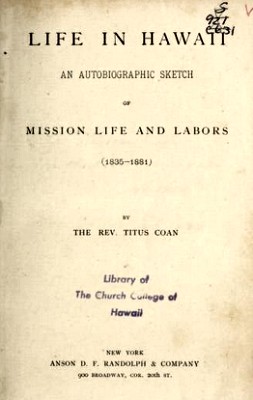Life
in Hawaii:
1835-1881.
Page 37
In order to save time and escape the weariness of the
road and the dangers of the rivers, I sometimes took a
canoe at the end of my tours to return home by the
water.
This trip required six to eight hours, and was usually
made in the night.
On three occasions my peril was great.
One description will suffice for all ; for although the
difficulties and escapes were at different points along
a precipitous and lofty sea-wall, yet the causes of
danger were the same, viz. : stormy winds, raging
billows, and want of landing-places.
About midway between our starting-place and Hilo harbor,
we were met by a strong head-wind, with pouring rain and
tumultuous waves in a dark midnight.
We were half a mile from land, but could hear the roar
and see the flashing of the white surf as it dashed
against the rocky walls. We could not land, we could
Page 38
not sail, we could not row forward or backward,
All we could do was to keep the prow of the canoe to the
wind, and bail.
Foaming seas dashed against our frail cockleshell,
pouring in buckets of brine.
Thus we lay about five hours, anxious as they "who watch
for the morning."
At length it dawned; we looked through the misty
twilight to the rock-bound shore where "the. waves
dashed high."
A few doors of native huts opened and men crawled out.
We called, but no echo came.
We made signals of distress.
We were seen and numbers came down to the cliffs and
gazed at us.
We waved our garments for them to come off to our help.
They feared, they hesitated.
We were opposite the mouth of a roaring river, where the
foam of breakers dashed in wild fury.
At last four naked men came down from the cliff, plunged
into the sea, dived under one towering wave after
another, coming out to breathe between the great rolling
billows, and thus reached our canoe.
Ordering the crew to swim to the land, they took charge
of the canoe themselves because they knew the shore.
Meanwhile men stood on the high bluffs with kapa cloth
in hand to signal to the boat-men when to strike for the
mouth of the river.
They waited long and watched the tossing waves as they
rolled in and thundered upon the shore, and when at last
a less furious wave came behind us, the shore men waved
the signals and cried out, "Hoi ! hoi !" and as the
waves lifted the
Page 39
stern of our canoe, all the paddles struck the water,
while the steerer kept the canoe straight on her course,
and thus mounted on this crested wave as on an ocean
chariot, with the feathery foam flying around us, we
rode triumphantly into the mouth of the river, where we
were received with shouts of gladness by the throng who
had gathered to witness our escape.
Then two rows of strong men waded into the surf up to
their arm-pits to receive our canoe and bear it in
triumph to the shore.
Naihe
https://en.wikipedia.org/wiki/Naihe
A Name-Song, a Eulogy (for Naihe)
Naihe's name chant, as translated by Emerson, follows:
The huge
roller, roller that surges from Kona,
Makes a loin-cloth fit for a
lord;
Far-reaching swell, my malo
(loin-cloth) streams in the wind;
Shape the crescent malo to the
loinsó
The loin-cloth the sea, cloth for
king's girdling.
Stand, gird fast the loin-cloth!
Let the sun guide the board
Halepo,
Till Halepo lifts on the swell.
It mounts the swell that rolls
from Kahiki,
From Wakea's age onrolling.
The roller plumes and ruffles its
crest.
Here comes the champion surf-man,
While wave-ridden wave beats the
island,
A fringe of mountain-high waves.
Spume lashes the Hiki-au altaró
A surf this to ride at noontide.
The coral, horned coral, it
sweeps far ashore.
We gaze at the surf of
Ka-kuhi-hewa.
The surf-board snags, is
shivered;
Maui splits with a crash,
Trembles, dissolves into slime.
Glossy the skin of the surf-man;
Undrenched the skin of the
expert;
Wave-feathers fan the wave-rider.
You've seen the grand surf of
Puna, of Hilo.



